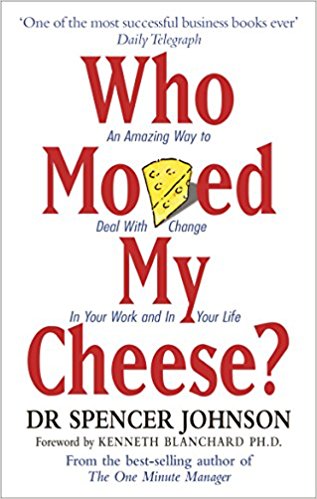Who Moved My Cheese Summary

6 min read ⌚

An Amazing Way to Deal with Change in Your Work and in Your Life
One of the most difficult things a person has to deal with in life is change. And, yet, changes are always happening. So, how do you get out of your comfort zone and face them?
“Who Moved My Cheese?” is a short motivational business fable through which Spencer Johnson tries to answer this question in a timeless manner.
See if it actually does in this summary.
Who Should Read “Who Moved My Cheese”? And Why?
If you were around in 1998 when “Who Moved My Cheese?” was published, you probably remember the worldwide phenomenon it instigated. Suddenly, every company had at least ten copies of the book and the ones which didn’t wait for the next edition to acquire them.
The result: “Who Moved My Cheese?” remained a “New York Times” bestseller for five years, sold almost 30 million copies, and was translated into more than 40 languages!
In other words, we’re pretty sure you have already read this book.
This summary is for the very few who haven’t.
About Spencer Johnson
Spencer Johnson was an American physician and widely read writer, mainly of children’s books and business fables.
was an American physician and widely read writer, mainly of children’s books and business fables.
In addition to “Who Moved My Cheese?,” Johnson is most famous for his contribution to the Value Tales series of books, and for his collaboration with Kenneth Blanchard, “The One Minute Manager.”
“Who Moved My Cheese? PDF Summary”
Strictly speaking, “Who Moved My Cheese?” is, in fact, a story within a story.
In other words, the main narrative is part of another one, which functions as a frame story.
In the case of “Who Moved My Cheese?”, the frame story is divided into a Prologue (“A Gathering: Chicago”) and an Epilogue (“A Discussion: Later That Day”).
The prologue sets the scene: a group of high school friends discusses how each of them is dealing with changes. One of them, named Michael, says that he didn’t know what to do until he heard “a funny little story that changed everything.”
Of course, everybody is interested in this story, and Michael reveals its title: “Who Moved My Cheese?” And that’s where the second story, the story within the story, begins.
And it’s a didactical one, a parable.
It features four allegorical versions of the self…
No, you know what? We’ll get to that later. In the “Key Lessons” section.
For now, let’s just tell you the story. It’s short, memorable, and effective.
So, two mice named “Sniff” and “Scurry” live in a maze where two “Little people,” “Hem” and “Haw” live as well. In the beginning, both groups have no cheese; but, both groups have a desire and dedication to find some.
So, they run around the maze and, finally, both groups arrive at “Cheese Station C,” which is nothing short of a cheese paradise!
There’s a vast cache of cheese there, or, in other words, just about enough to feed both groups for a long period of time.
The mice, acting instinctively, don’t really think about the future! They run straight from their homes to Cheese Station C every day, acting as if there would be no cheese left one day. The humans are more laidback and establish some routines.
Since they know there’s quite enough cheese for some time, they make the mistake of falling back in their comfort zone and even becoming a bit arrogant in the process.
But, one day, there’s no more cheese left.
The mice are prepared for such a scenario and almost immediately start looking for another cache. Hem and Haw – not so much.
Once again, they start acting irresistibly and worriedly human.
They start blaming anyone but them for their misfortune, with Hem even going in a state of serious denial. It’s he who, at this point exclaims: “Who moved my cheese?” – as if it was only his, to begin with.
Feeling the world has treated him unfairly, Hem doesn’t want to go to search for new cheese. And no matter what he does, Haw is unable to motivate him.
Meanwhile, Sniff and Scurry reach the “Cheese Station N” and happen upon another rich cache of their favorite dish.
Haw seems like the only one able to follow them. One day, he starts taking the situation a little bit less seriously. It’s not a cataclysm, he thinks, it’s merely a new beginning.
So, he decides to move on. So as to inspire his friend a bit as well, he scribbles on the wall of “Cheese Station C,” thought-provoking writing: “If You Do Not Change, You Can Become Extinct.”
And Haw embarks on his next journey.
Behind him, however, he leaves a trail of messages on the walls, which Johnson playfully calls “The Handwriting on the Wall.” The messages have a two-fold function: both, a thought-clearing mechanism for Haw, and a possible motivator for Hem.
One day, Haw reaches “Cheese Section N” and finds even more abundant reservoir of cheese than the one in “Section C”. Moreover, some of the types here are tastier and more exotic.
Haw wishes to share the cheese with his friend. But he decides to let him find his own way.
Wary of his past experience, Haw repeatedly explores other trails in the maze, fearing that one day the cheese he’s eating will disappear as well.
One day, Haw hears some movement in the maze.
And as the footsteps near, he hopes that they are his friend Hem’s footsteps.
Maybe, finally, he found his way too.
Key Lessons from “Who Moved My Cheese”
1. Why Do We Write Parables?
2. Four Types of Characters
3. The Handwriting on the Wall
Why Do We Write Parables?
In a nutshell, a parable is a simple story with a moral.
It intends to impart important knowledge through an allegory. A good way to understand why “Who Moved My Cheese?” is an allegory is to think about how would you read it one of its four main characters, had your name and description.
Surely, you’d be in a state of denial like Ham, claiming that you wouldn’t act like that.
Don’t worry!
That’s a normal reaction.
That’s why we have parables and fables. When the stories are about mice and little men, everyone can find some part of himself inside the stories.
And, that’s how any “funny little story” can become a bestseller.
Four Types of Characters
Some editions of “Who Moved My Cheese?” feature a short introduction describing each of the four characters.
It says that they are intended to represent “the simple and the complex parts of ourselves,” and, that all of us can be either one of the characters in the story or a combination of two or more.
Sniff is the one who sniffs a challenge before one actually arises. He’s proactive and down to business, always a step ahead.
Scurry is the one who scurries into action the second he hears the call. He isn’t passive as well, and he knows that change will inevitably come. So, he prepares in advance.
Haw is the one who learns to adapt the minute he understands that change may lead to something better. He’s one step behind, but he moves forward, nevertheless.
Finally, Hem is the one who denies the necessity of change. He resists transformations of any kind, believing that the status quo is the optimal status of a system.
He’s the one who’ll be left behind.
The Handwriting on the Wall
The writings Haw leaves on the walls for Hem are, of course, messages intended for the readers.
Pay attention to them!
They teach you how changes are inevitable and how you must adapt to them, leaving all fears behind you.
Like this summary? We’d Like to invite you to download our free 12 min app, for more amazing summaries and audiobooks.
“Who Moved My Cheese” Quotes
If you do not change, you can become extinct. Share on X What would you do if you weren’t afraid? Share on X When you stop being afraid, you feel good! Share on X Noticing small changes early helps you adapt to the bigger changes that are to come. Share on X Be ready to change quickly and enjoy it again & again! Share on XOur Critical Review
“Who Moved My Cheese?” isn’t much longer than our summary. When you think about it, it also seems that it doesn’t really have that much more to say. The prologue and the epilogue are superfluous, and the main story may be told in even fewer sentences.
We know that “Who Moved My Cheese?” is a classic, but we feel that it hasn’t aged that well. There are some holes in the parable, which isn’t too much to start with. Because, after all is said and done, its moral is quite simple.
The late great David Bowie has even sung it, memorably: Ch-ch-ch-ch-changes, turn and face the strange…








